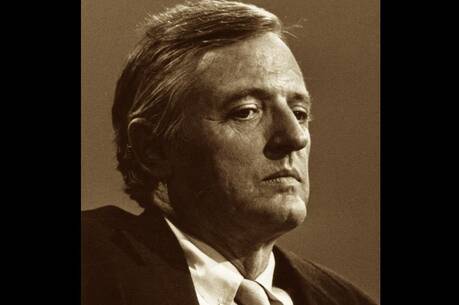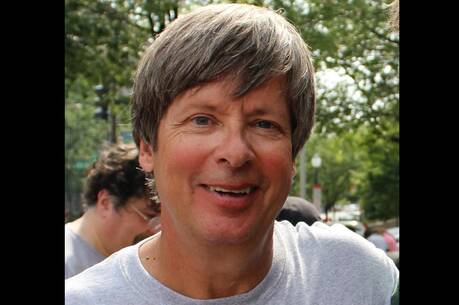Review: Oscar Wilde’s quest for identity
In January 1882, Oscar Wilde, 27 years old and still little-known, began his yearlong, coast-to-coast, 15,000-mile lecture tour throughout the United States. The ostensible purpose was to publicize the U.S. tour of Gilbert and Sullivan’s “Patience,” whose precious aesthete Bunthorne—“what a very singularly deep young man this deep young man must be!”—was partly based on Wilde. But the real reason was to promote himself as a celebrity while searching for his true sexual identity.
In the Victorian period men had to hide their homosexuality, but Wilde found a way to flaunt his feelings. Wearing a theatrical costume while behaving outrageously on stage, his ambiguous sexuality became entertainment. His marriage in 1884 and his two sons (Cyril and Vyvyan) as well as the appearance of male lovers (Robbie Ross in 1886 and Lord Alfred Douglas in 1891) were still in the future. Wilde did not marry to “cure” his homosexuality. He fell in love with an attractive woman, but discovered that his deepest erotic yearnings were for men.
Wilde was better known for his wit than for his lectures, a long-running, one-man show, written by and starring himself. When he arrived at U.S. Customs he said, “I have nothing to declare but my genius.” He rated the Atlantic Ocean “disappointing” and would have preferred more turbulence. He also put down the nation’s iconic cataract: “I was disappointed with Niagara. Every American bride is taken there and the sight of the stupendous waterfall must be one of the earliest, if not the keenest, disappointments in American married life.”
When Oscar Wilde arrived at U.S. Customs he said, “I have nothing to declare but my genius.”
Wilde was six feet, four inches tall, weighed 200 pounds and had thick lips and a puffy face. His lectures mixed paradox and wit, eccentricity and nonsense while spreading the war cry of beauty amid the agonizing ugliness of 19th-century American dress and décor. He favored a long fur-trimmed green coat, wide Byronic collar, knee breeches, silk stockings, silver-buckled pumps and a yellow handkerchief. The “queer, high-flavored fruit” seemed defective in masculinity.
Wilde’s character was enigmatic, both appalling and appealing. He was Irish and English, an ass but clever, feminine and masculine, aesthetic and athletic. He wore Buffalo Bill’s shoulder-length hair and was a heavy drinker. He went down into the mines with the bearded ruffians of Leadville, Colo.—“the roughest and most wicked town on earth”—then supped on three courses of whiskey and was hailed as a hero, a man’s man and one of their own. Wilde’s repertoire of masks, talent for self-fashioning and skillful reinvention transformed him into a media star. In this respect, he foreshadowed modern U.S. writers whose flamboyant personalities attracted many readers: Hemingway and Mailer as well as the defiant gay writers Gore Vidal and Truman Capote.
While trying to solve the mystery of Wilde’s identity as she wrote Making Oscar Wilde, Michèle Mendelssohn developed a new approach to biographical research. Vast online archives and databases provided a digital treasure trove of local newspapers in the obscure towns where Wilde had lectured that was unavailable to previous life-writers. Her innovative approach and exploration of unsuspected territory has yielded rich results, illuminating new aspects of Wilde’s life and afterlife. Making Oscar Wilde reveals that his bold attempt to “civilize” U.S. taste and culture was closely connected to both 19th-century and contemporary debates about evolution, racial hierarchies, concepts of the primitive, ethnological hoaxes and popular theatrical performances. She belatedly states her theme on the last page of her lively, original and valuable work: “His story is intertwined with the history of Anglo-American society as it grappled with massive waves of immigration, nationalist movements, racial and ethnic conflicts, political upheavals, new media technologies and a sensation-hungry press.”
Mendelssohn makes the most of a hot issue in Wilde’s time and still a frequent subject in our own by connecting him to the rabid racism in the United States soon after Darwin’s The Origin of Species and the end of the U.S. Civil War. The waves of poor Irish immigrants to the United States were at the bottom of white society, and the recently freed slaves were crushed beneath the Irish. The Irish Wilde, who traveled with a black servant he jokingly called “my slave,” was savagely caricatured by the hostile press. “The Wilde Man of Borneo” was portrayed as an evolutionary throwback, primitive degenerate and “negrofied Paddy,” closely linked to both monkeys and the shows of blackface minstrels.
The most interesting events of his tour were his crucial meetings with Walt Whitman in Camden, N.J., and with Henry James in Washington. Whitman had also created an attractive public persona. But there was a great contrast in age and appearance between the precious, pretentious, flamboyant fop that was Wilde and the bearded, hearty man of the people that was Whitman. Since Wilde came to pay tribute and Whitman magnanimously accepted it, the two giant egos got on well. Praising the qualities in Whitman that were so different from his own, Wilde declared, “He is the grandest man I have ever seen, the simplest, most natural, and strongest character I have ever met in my life.”
Wilde lamented that “the gods had given me almost everything. I had genius, a distinguished name, high social position, brilliancy, intellectual daring” and had “lost wife, children, fame, honour, position, wealth.”
In interviews about Whitman, Wilde talked about ancient Greek love, an idealized code for sex between men. Wilde later revealed that the poet “had made no effort to conceal his homosexuality,” and “the kiss of Walt Whitman is still on my lips.” Like Whitman, he tried to tell the truth about himself when describing his own poetry as “the song of Sex, of Amativeness, and even Animality.”
While Whitman was warm and companionable with Wilde, Henry James was frosty and hostile. James was repelled by Wilde’s costume, contemptuous of his self-promotion, critical of his endless wandering and uneasy about his sexuality. He called Wilde “a fatuous fool,” “a tenth-rate cad” and “an unclean beast,” and later satirized him in The Tragic Muse as the restless aesthete Gabriel Nash.
Wilde was the agent of his own destruction. He rashly filed a libel suit against the Marquess of Queensbury—father of his idol, tormentor and nemesis Lord Alfred Douglas. But he did not realize that Queensbury had acquired damaging evidence to justify his accusation that Wilde was a “sodomite.” After losing this case, Wilde was prosecuted for the sexual crime of “gross indecency.” He then refused to flee to France to avoid arrest and remained to face his punishment. Provocative and aggressive in court, instead of charming and sympathetic, he was sentenced to solitary confinement and two years of hard labor.
He lamented that “the gods had given me almost everything. I had genius, a distinguished name, high social position, brilliancy, intellectual daring” and had “lost wife, children, fame, honour, position, wealth.” As Samuel Johnson wrote of his infamous examples in The Vanity of Human Wishes, “They mount, they shine, evaporate, and fall.” In a series of spectacular transformations, Wilde went from obscurity to fame as the leading British playwright, to notoriety and ruin, and then to an almost miraculous rehabilitation as a modern martyr and saint.
This article also appeared in print, under the headline “His quest for identity ,” in the February 4, 2019, issue.










